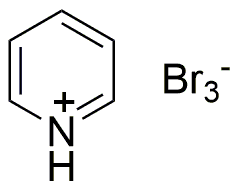Pyridinium tribromide is widely utilized in research focused on:
- Synthetic Chemistry: This compound serves as a brominating agent, facilitating the introduction of bromine into organic molecules, which is crucial for creating various pharmaceuticals and agrochemicals.
- Organic Synthesis: It is employed in the synthesis of heterocyclic compounds, enhancing the efficiency of reactions and providing a more straightforward pathway for complex molecule construction.
- Analytical Chemistry: Pyridinium tribromide is used in analytical methods to detect and quantify specific organic compounds, making it valuable in quality control processes in laboratories.
- Environmental Chemistry: This chemical can be applied in the degradation of pollutants, aiding in the development of methods for environmental remediation.
- Material Science: It is explored in the development of new materials, particularly in creating polymeric substances with enhanced properties through bromination reactions.
General Information
Properties
Safety and Regulations
Applications
Pyridinium tribromide is widely utilized in research focused on:
- Synthetic Chemistry: This compound serves as a brominating agent, facilitating the introduction of bromine into organic molecules, which is crucial for creating various pharmaceuticals and agrochemicals.
- Organic Synthesis: It is employed in the synthesis of heterocyclic compounds, enhancing the efficiency of reactions and providing a more straightforward pathway for complex molecule construction.
- Analytical Chemistry: Pyridinium tribromide is used in analytical methods to detect and quantify specific organic compounds, making it valuable in quality control processes in laboratories.
- Environmental Chemistry: This chemical can be applied in the degradation of pollutants, aiding in the development of methods for environmental remediation.
- Material Science: It is explored in the development of new materials, particularly in creating polymeric substances with enhanced properties through bromination reactions.
Documents
Safety Data Sheets (SDS)
The SDS provides comprehensive safety information on handling, storage, and disposal of the product.
Product Specification (PS)
The PS provides a comprehensive breakdown of the product’s properties, including chemical composition, physical state, purity, and storage requirements. It also details acceptable quality ranges and the product's intended applications.
Certificates of Analysis (COA)
Search for Certificates of Analysis (COA) by entering the products Lot Number. Lot and Batch Numbers can be found on a product’s label following the words ‘Lot’ or ‘Batch’.
*Catalog Number
*Lot Number
Certificates Of Origin (COO)
This COO confirms the country where the product was manufactured, and also details the materials and components used in it and whether it is derived from natural, synthetic, or other specific sources. This certificate may be required for customs, trade, and regulatory compliance.
*Catalog Number
*Lot Number
Safety Data Sheets (SDS)
The SDS provides comprehensive safety information on handling, storage, and disposal of the product.
DownloadProduct Specification (PS)
The PS provides a comprehensive breakdown of the product’s properties, including chemical composition, physical state, purity, and storage requirements. It also details acceptable quality ranges and the product's intended applications.
DownloadCertificates of Analysis (COA)
Search for Certificates of Analysis (COA) by entering the products Lot Number. Lot and Batch Numbers can be found on a product’s label following the words ‘Lot’ or ‘Batch’.
*Catalog Number
*Lot Number
Certificates Of Origin (COO)
This COO confirms the country where the product was manufactured, and also details the materials and components used in it and whether it is derived from natural, synthetic, or other specific sources. This certificate may be required for customs, trade, and regulatory compliance.


